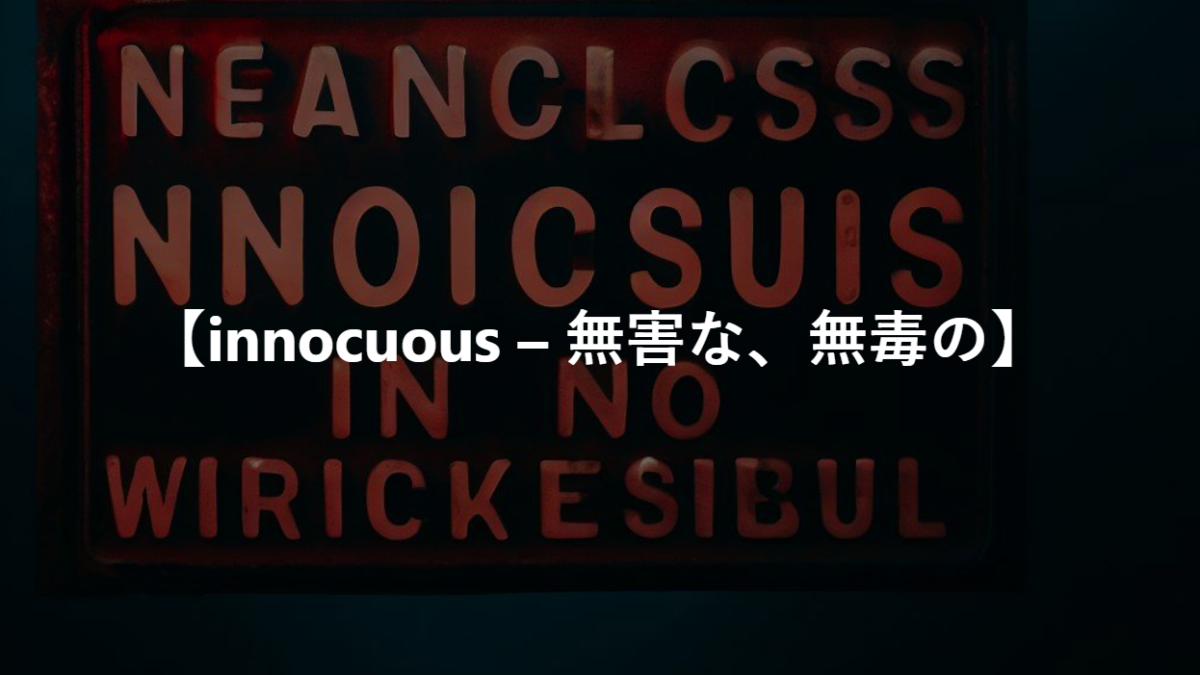語源・類義語・反対語・例文
【innocuous – 無害な、無毒の】という単語の語源とか由来を知っていますか?
「innocuous」はラテン語の「innocuus」から来ており、これは「in-」(ない)と「nocuus」(害を与える)から成る合成語です。「nocuus」は「nocēre」(害する)に由来しており、直訳すると「害のない」または「無害な」という意味になります。したがって、「innocuous」の語源は、文字通りには「害を与えない」または「無害な」ことを指しており、主に害や悪影響を及ぼさないものを表す言葉として英語に取り入れられました。時間が経つにつれ、この言葉は物質や行動、発言など、あらゆる害のないものや状況を指すのに使用されるようになりました。
“Innocuous” originates from the Latin word “innocuus,” which is a compound of “in-” (not) and “nocuus” (harmful). “Nocuus” itself derives from “nocēre,” meaning “to harm,” thus translating directly to “harmless” or “without harm.” Therefore, the etymology of “innocuous” literally refers to something that “does not harm” or is “harmless,” and it was adopted into English primarily to describe something that does not cause injury or adverse effects. Over time, the word has come to be used to denote anything that is harmless, including substances, actions, or remarks, in various contexts.
この単語の類義語・反対語を教えてください。
類義語:
- harmless – 害のない
- safe – 安全な
- benign – 良性の
- non-toxic – 無毒の
- inoffensive – 不快感を与えない
反対語:
- harmful – 有害な
- dangerous – 危険な
- toxic – 有毒の
- malignant – 悪性の
- injurious – 害を及ぼす
この単語を使った例文を5つほど教えてください。
The chemical used in the cleaning product is innocuous and poses no harm to the environment.
(その掃除用品に使用されている化学物質は無害であり、環境に害を与えません。)
The spider in the garden is innocuous and does not pose a threat to humans.
(庭のクモは無害であり、人間に脅威を与えません。)
Despite its fierce appearance, the wild animal is innocuous and avoids human contact.
(その野生動物は凶暴な外見にも関わらず、無害であり、人間との接触を避けます。)
The plant may look harmless, but some species have innocuous-looking berries that are actually toxic if consumed.
(その植物は無害に見えるかもしれませんが、一部の種は無害に見えるベリーを持っており、実際には摂取すると毒性があります。)
The comedian’s jokes were innocuous and brought laughter to the audience without offending anyone.
(そのコメディアンのジョークは無害であり、誰も不快にさせることなく観客に笑いをもたらしました。)
【innocuous – 無害な、無毒の】のコロケーション
- Innocuous substance – 「無害な物質」
- 化学物質や食品など、人体や環境に害を与えない物質を指します。この表現は、特に安全性が強調されたい場合に使われます。
- Innocuous comment – 「無害なコメント」
- 誰かの感情を傷つけたり、不快にさせたりしない発言を意味します。社会的な場や会話の中で、他者を尊重し、衝突を避けるために使われることがあります。
- Innocuous question – 「無害な質問」
- 相手に不快感や不安を与えない、純粋な好奇心からの質問を指します。この種の質問は、通常、情報を得るために、または会話を続けるために使われます。
- Appear innocuous – 「無害に見える」
- 最初は無害や問題ないように見えるが、実際には潜在的な問題を含むかもしれない状況や物事を指します。この表現は、外見と実際の性質が異なる可能性がある場合に用いられます。
「innocuous」は、無害な、無毒のという意味を持つ単語です。これは、人体や環境に悪影響を及ぼさないものや状況を指すために使用されます。この単語を含む様々なコロケーションがあり、それらは「innocuous」がどのような文脈で使われるかを具体的に示しています。
Innocuous substanceは、人体や環境に害を与えない物質、例えば安全な化学物質や食品を指します。この表現は、安全性に関する議論や説明の中で頻繁に使用されます。
Innocuous commentは、他人の感情を害することなく、むしろ穏やかな印象を与える発言を意味します。社交的な場面やデリケートな話題を扱う際に役立つ表現です。
Innocuous questionは、相手を不快にさせることなく、純粋な好奇心から投げかけられる質問を指します。これは、会話をスムーズに進めたい時や、相手に負担をかけずに情報を得たい時に便利です。
Appear innocuousは、表面上は無害や安全に見えるが、実際には潜在的な問題を秘めている可能性がある状況や物事を示します。見た目と実態が一致しない場合に使われる表現です。
これらのコロケーションは、「innocuous」がさまざまな文脈でどのように活用されるかを理解するのに役立ちます。無害さや安全性を伝える際に、これらの表現が有効に使われることがあります。
The term “innocuous” means harmless or non-toxic, used to describe things or situations that do not cause harm to human health or the environment. There are various collocations that include this word, which specifically illustrate how “innocuous” is used in different contexts.
Innocuous substance refers to materials, such as safe chemicals or food items, that do not cause harm to the body or the environment. This expression is frequently used in discussions or explanations about safety.
Innocuous comment means a remark that does not offend others but rather leaves a mild impression. It is useful in social situations or when dealing with delicate topics.
Innocuous question points to a question asked out of pure curiosity without making the other party uncomfortable. It is handy when wanting to keep a conversation flowing smoothly or when seeking information without imposing on someone.
Appear innocuous indicates a situation or thing that seems harmless or safe on the surface but may contain potential issues. This expression is used when there’s a discrepancy between appearances and actual conditions.
These collocations help understand how “innocuous” can be utilized across various contexts, proving effective in conveying harmlessness or safety.
innocuousを使った英文法問題5問
- 語彙問題
次のうち、innocuousの意味として最も適切なものはどれですか?
- a. 有害な
- b. 危険な
- c. 無害な
- d. 攻撃的な
解答と解説
- c. 無害な
innocuousは「無害な、無毒の、悪意のない」という意味の形容詞です。
- 空所補充
次の文の( )内に入る最も適切な単語はどれですか?
The snake’s venom was surprisingly ( ), causing only mild discomfort.
- a. innocuous
- b. innocuously
- c. innocuousness
- d. innocuity
解答と解説
- a. innocuous
空所には、be動詞wasの後に続く補語となる形容詞が入ります。innocuousは「無害な」という意味の形容詞です。
- 品詞の識別
次の文のinnocuousnessは何詞として使われていますか?
The innocuousness of the comment surprised everyone.
- a. 名詞
- b. 動詞
- c. 形容詞
- d. 副詞
解答と解説
- a. 名詞
innocuousnessは「無害、無毒」という意味の名詞です。innocuousの名詞形です。
- 類義語の使い分け
次の文の( )内に入る最も適切な単語はどれですか?
The vaccine is ( ) and has no serious side effects.
- a. innocuous
- b. harmless
解答と解説
- a. innocuous または b. harmless
innocuousとharmlessはどちらも「無害な」という意味ですが、innocuousは「悪意や危険がない」というニュアンスが強く、harmlessは「害や損傷を与えない」というニュアンスで使われます。この文脈では、どちらの単語も適切です。
- 文法的な誤りの指摘
次の文には文法的な誤りが1箇所あります。その誤りを含む部分を指摘し、正しい形に直してください。
The innocuously looking plant turned out to be poisonous.
解答と解説
- 誤り: innocuously
- 正しい形: innocuous
innocuouslyは副詞であり、ここでは名詞plantを修飾する形容詞innocuousを使うべきです。

